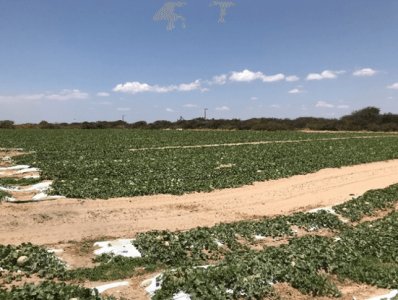AQUA4D Brasil Agronomist, George Hércules de Melo, explores the ameliorating effects of water-smart technology in challenging irrigation settings, such as saline water or salt-saturated soils.
Understanding the root absorption mechanism
Crops installed in soils with high salt content and/or irrigated with brackish water present developmental problems, resulting in very low yields. This fact is due to the plants’ low capacity to absorb water and soil nutrients.
For there to be ionic exchange between the soil and the plant, there must be an osmotic condition that favors its absorption. Plants use a lot of energy to make this exchange, due to the osmotic differential between the saline concentration of the plant’s sap and the concentration of the solution of the saline soil. This means the plant must make a strenuous effort to absorb the water it needs.
In high salinity conditions, even with frequent irrigation the water available is not sufficient for the plant to maintain its vital functions, closing the stomata on a hot and sunny day, and no longer conducting photosynthesis. Over time, the detrimental effects on plants and yields become only too clear.

Transforming the water-soil-plant relationship
The water clusters found in nature are mostly formed by hundreds of water molecules (H2O). AQUA4D® treatment results in the defragmentation of these clusters. These smaller water clusters then lead to a greater penetration into the micro pores of the soil. This increases water availability in the soil, keeping soils and plants hydrated for longer. Additionally, with harmful salts efficiently carried below the root zone, plants can now optimize their physiological activities.
For crops exposed to extreme external conditions, AQUA4D® treatment entails less plant stress, promotes better development, and results in increased productivity & yields.
The new conditions in the water-soil-plant relationship brought about by AQUA4D® have been proven in various cases around the world, and several noteworthy examples in Brazil.
Rio Grande do Norte: saline soil regeneration
Agricola Famosa, the largest fruit producer in Brazil, were irrigating their melon crops with saline water (EC 3.0-6.0). Over time, salt had accumulated to such an extent that productivity was suffering – they were faced with moving production to a new area. They first trialed the AQUA4D® system in 2014 on a 24 ha plot. (Find out more in this video interview with company director Richard Müller).
It quickly became apparent to the agronomists at Agricola Famosa that salt was moving out of the soil, the water quality was improving, and plant health improved beyond recognition (yield increases of 7-17%).
Minas Gerais: irrigation uniformity and moisture
Results from a large coffee grower in Minas Gerais were a clear example of the improved soil-water-plant relationship through AQUA4D®. Greater irrigation uniformity and soil moisture had a direct and profound impact on productivity come harvest time – increasing yields by 27% (click left image to expand).
Prof. Eusímio F. Fraga from Instituto de Ciências Agrárias (UFU) told a recent AÇÃO AGRO interview: “The difference in coffee plants is clear: the size of the plants, their vigour, the colour of the leaves and, of course, the increase in productivity” (full video link here).
Conclusion
The optimization of plant performance is of interest at all levels of agriculture, but when coupled with extreme soil or water conditions, failing to make adjustments can have existential threats for crops. AQUA4D has shown how transforming poor quality irrigation water can reset this fundamental water-soil-plant nexus, having both curative and preventive effects – ultimately measured by producers in saved labor hours, higher yields, and regenerated land.

Brazil
Water-Smart Agriculture
Precision Irrigation
Webinar: George Melo explains water management with AQUA4D
The Science: The absorption of water and nutrients takes place via the symplast route and via the apoplast route. The symplast route occurs through the cell membrane and therefore requires an osmotic differential. The nutrients are absorbed by diffusion together with the water. The absorption by the apoplast occurs without the need for osmotic potentials, since the flow of the water together with the nutrients occurs between the cells until it reaches the xylem. The absorption in this case is via “mass flow”, giving preference to the most soluble nutrients such as nitrogen.




